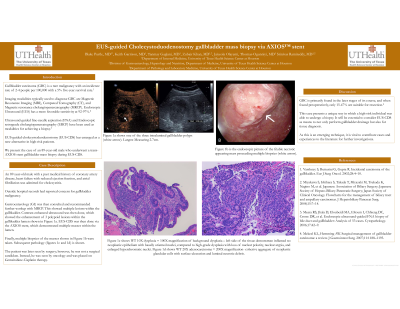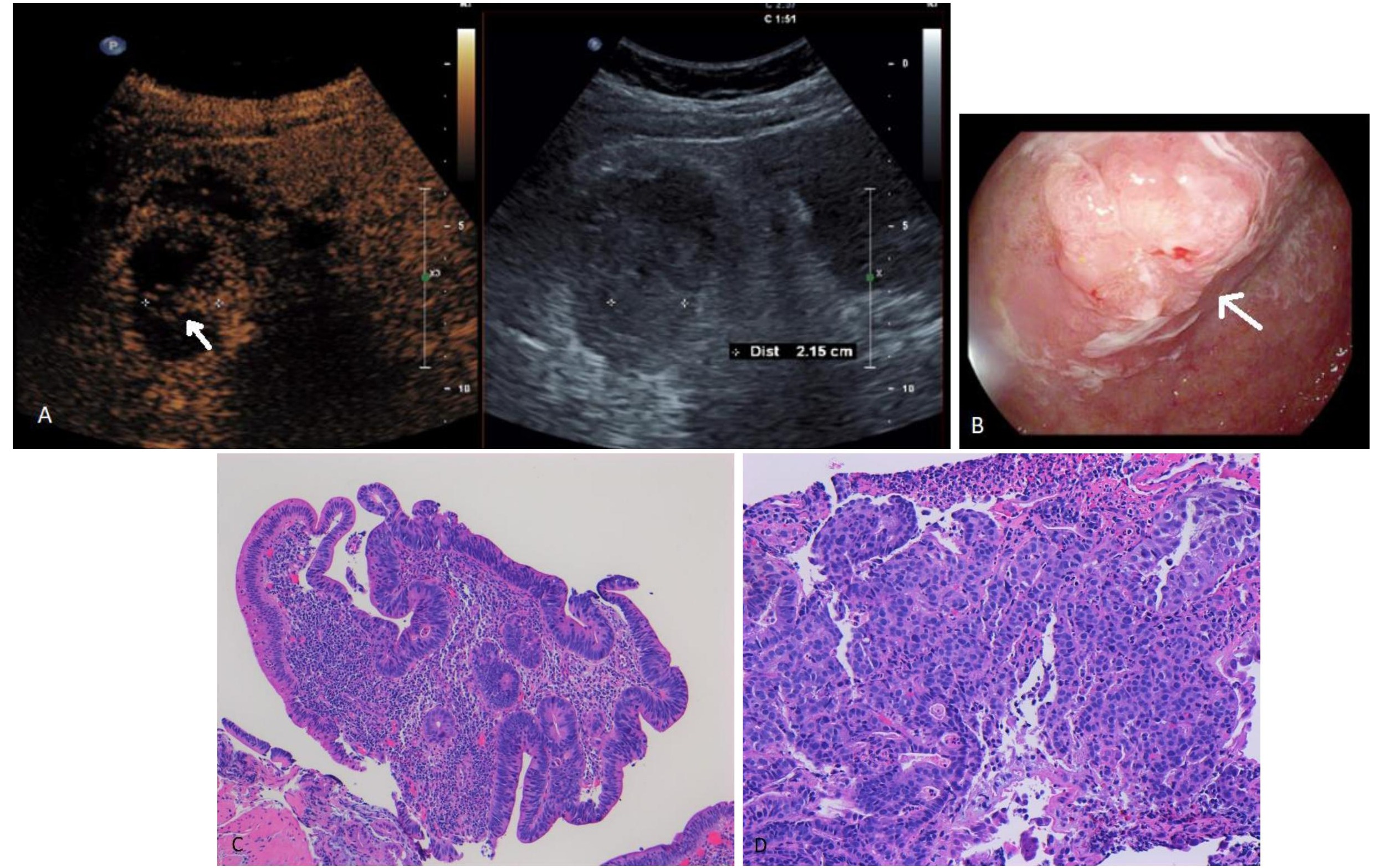Back


Poster Session D - Tuesday Morning
Category: Interventional Endoscopy
D0462 - EUS-Guided Cholecystoduodenostomy Gallbladder Mass Biopsy via AXIOS™ Stent
Tuesday, October 25, 2022
10:00 AM – 12:00 PM ET
Location: Crown Ballroom

Has Audio

Blake Purtle, MD
The University of Texas Houston Health Science Center
Houston, TX
Presenting Author(s)
Blake Purtle, MD1, Keith Garrison, MD2, Tanmay Gaglani, MD3, Zubair Khan, MD4, Jamie Everett, MD4, Srinivas Ramireddy, MD4
1The University of Texas Houston Health Science Center, Houston, TX; 2University of Texas Houston Health Sciences Center, Houston, TX; 3The University of Texas Health Science Center at Houston, Houston, TX; 4University of Texas Health Science Center, Houston, TX
Introduction: Gallbladder carcinoma (GBC) is a rare malignancy with an incidence rate of 2-4 people per 100,000 with a 5% five-year survival rate.1 Imaging modalities typically used to diagnose GBC are Magnetic Resonance Imaging (MRI), Computed Tomography (CT), and Magnetic resonance cholangiopancreatography (MRCP). However, an emerging diagnostic technique is Endoscopic Ultrasound (EUS) which has a more favorable sensitivity at 92-97%.2 Following imaging diagnostics, either surgery or tissue biopsy is sought. Ultrasound-guided fine-needle aspiration (FNA) and Endoscopic retrograde cholangiopancreatography (ERCP) have been used as modalities for achieving a biopsy.3
EUS-guided cholecystoduodenostomy (EUS-CDS) has emerged as a new alternative in high-risk patients. This procedure involves using endoscopic ultrasound to identify an area where the AXIOS delivery catheter can be inserted to deploy a stent. We present the case of an 89-year-old male who underwent a trans-AXIOS stent gallbladder mass biopsy during EUS-CDS.
Case Description/Methods: An 89-year-old male with a past medical history of coronary artery disease, heart failure with reduced ejection fraction, and atrial fibrillation was admitted for cholecystitis. Interventional radiology (IR) was consulted to place a percutaneous cholecystostomy tube. Outside hospital records had reported concern for gallbladder malignancy. Gastroenterology (GI) was then consulted and recommended further workup with MRCP. This showed multiple lesions within the gallbladder. Contrast-enhanced ultrasound was then done, which showed the enhancement of 3 polypoid lesions within the gallbladder lumen shown in Figure 1a. EUS-CDS was then done via the AXIOS stent, which demonstrated multiple masses within the lumen. Finally, multiple biopsies of the masses shown in Figure 1b were taken. Subsequent pathology (figures 1c and 1d) is shown.
The patient was later seen by surgery; however, he was not a surgical candidate. Instead, he was seen by oncology and was placed on Gemcitabine-Cisplatin therapy.
Discussion: GBC is primarily found in the later stages of its course, and when found preoperatively, only 15-47% are suitable for resection.4 This case presents a unique way in which a high-risk individual was able to undergo a biopsy. It will be essential to consider EUS-CDS as means to not only perform gallbladder drainage but also for tissue diagnosis. As this is an emerging technique, it is vital to contribute cases and experiences to the literature for further investigations.

Disclosures:
Blake Purtle, MD1, Keith Garrison, MD2, Tanmay Gaglani, MD3, Zubair Khan, MD4, Jamie Everett, MD4, Srinivas Ramireddy, MD4. D0462 - EUS-Guided Cholecystoduodenostomy Gallbladder Mass Biopsy via AXIOS™ Stent, ACG 2022 Annual Scientific Meeting Abstracts. Charlotte, NC: American College of Gastroenterology.
1The University of Texas Houston Health Science Center, Houston, TX; 2University of Texas Houston Health Sciences Center, Houston, TX; 3The University of Texas Health Science Center at Houston, Houston, TX; 4University of Texas Health Science Center, Houston, TX
Introduction: Gallbladder carcinoma (GBC) is a rare malignancy with an incidence rate of 2-4 people per 100,000 with a 5% five-year survival rate.1 Imaging modalities typically used to diagnose GBC are Magnetic Resonance Imaging (MRI), Computed Tomography (CT), and Magnetic resonance cholangiopancreatography (MRCP). However, an emerging diagnostic technique is Endoscopic Ultrasound (EUS) which has a more favorable sensitivity at 92-97%.2 Following imaging diagnostics, either surgery or tissue biopsy is sought. Ultrasound-guided fine-needle aspiration (FNA) and Endoscopic retrograde cholangiopancreatography (ERCP) have been used as modalities for achieving a biopsy.3
EUS-guided cholecystoduodenostomy (EUS-CDS) has emerged as a new alternative in high-risk patients. This procedure involves using endoscopic ultrasound to identify an area where the AXIOS delivery catheter can be inserted to deploy a stent. We present the case of an 89-year-old male who underwent a trans-AXIOS stent gallbladder mass biopsy during EUS-CDS.
Case Description/Methods: An 89-year-old male with a past medical history of coronary artery disease, heart failure with reduced ejection fraction, and atrial fibrillation was admitted for cholecystitis. Interventional radiology (IR) was consulted to place a percutaneous cholecystostomy tube. Outside hospital records had reported concern for gallbladder malignancy. Gastroenterology (GI) was then consulted and recommended further workup with MRCP. This showed multiple lesions within the gallbladder. Contrast-enhanced ultrasound was then done, which showed the enhancement of 3 polypoid lesions within the gallbladder lumen shown in Figure 1a. EUS-CDS was then done via the AXIOS stent, which demonstrated multiple masses within the lumen. Finally, multiple biopsies of the masses shown in Figure 1b were taken. Subsequent pathology (figures 1c and 1d) is shown.
The patient was later seen by surgery; however, he was not a surgical candidate. Instead, he was seen by oncology and was placed on Gemcitabine-Cisplatin therapy.
Discussion: GBC is primarily found in the later stages of its course, and when found preoperatively, only 15-47% are suitable for resection.4 This case presents a unique way in which a high-risk individual was able to undergo a biopsy. It will be essential to consider EUS-CDS as means to not only perform gallbladder drainage but also for tissue diagnosis. As this is an emerging technique, it is vital to contribute cases and experiences to the literature for further investigations.

Figure: Figure 1a shows one of the three intraluminal gallbladder polyps (white arrow). Largest Measuring 2.7cm. Figure 1b is the endoscopic picture of the friable necrotic appearing mass proceeding multiple biopsies (white arrow). Figure 1c shows WT 10X dysplasia = 100X magnification of background dysplasia – left side of the tissue demonstrate inflamed no neoplastic epithelium with basally oriented nuclei, compared to high-grade dysplasia with loss of nuclear polarity, nuclear atypia, and enlarged hyperchromatic nuclei. Figure 1d shows WT 20X adenocarcinoma = 200X magnification- cohesive aggregate of neoplastic glandular cells with surface ulceration and luminal necrotic debris.
Disclosures:
Blake Purtle indicated no relevant financial relationships.
Keith Garrison indicated no relevant financial relationships.
Tanmay Gaglani indicated no relevant financial relationships.
Zubair Khan indicated no relevant financial relationships.
Jamie Everett indicated no relevant financial relationships.
Srinivas Ramireddy indicated no relevant financial relationships.
Blake Purtle, MD1, Keith Garrison, MD2, Tanmay Gaglani, MD3, Zubair Khan, MD4, Jamie Everett, MD4, Srinivas Ramireddy, MD4. D0462 - EUS-Guided Cholecystoduodenostomy Gallbladder Mass Biopsy via AXIOS™ Stent, ACG 2022 Annual Scientific Meeting Abstracts. Charlotte, NC: American College of Gastroenterology.
